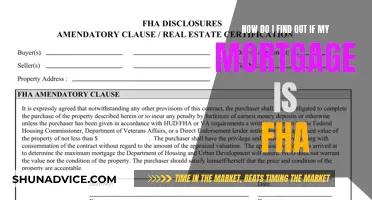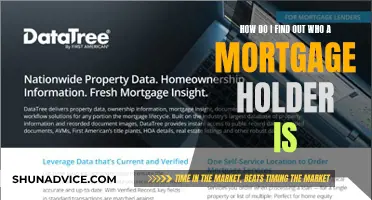
The Home Affordable Refinance Program (HARP) was a federal program set up by the US government to help underwater and near-underwater homeowners refinance their mortgages. The program was established in 2009 and ended in 2018. If you had a loan-to-value ratio (LTV) of greater than 80% and were current on your mortgage payments, you may have qualified for a HARP mortgage. To find out if you have a HARP mortgage, you can check with your current lender or look up your loan on the Fannie Mae and Freddie Mac websites.
| Characteristics | Values |
|---|---|
| Other names | Making Home Affordable, DU Refi Plus, Relief Refinance, The Obama Refi, A Better Bargain For U.S. Homeowners |
| Started | April 2009 |
| Ended | December 2018 |
| Administered by | Federal Housing Finance Agency |
| Eligibility | Your loan must be backed by Freddie Mac or Fannie Mae; your current mortgage must have a note date of no later than May 31, 2009; you must be current on your mortgage payments, with no more than one 30-day late payment in the last 12 months; your loan-to-value ratio must be greater than 80% |
| Ineligibility | If your mortgage is an FHA, USDA, VA or a jumbo mortgage |
What You'll Learn

HARP eligibility requirements
The Home Affordable Refinance Program (HARP) is a federal program of the United States government, set up by the Federal Housing Finance Agency in March 2009, to help underwater and near-underwater homeowners refinance their mortgages. The program ended in 2018.
To be eligible for HARP, you must meet the following requirements:
- Your mortgage must be owned or guaranteed by Freddie Mac or Fannie Mae.
- Your mortgage must have been acquired by Freddie Mac or Fannie Mae on or before 31 May 2009.
- You must not have previously refinanced your mortgage through HARP, unless it is a Fannie Mae loan that was refinanced under HARP during March–May 2009.
- You must be current on your mortgage payments, with no late (30-day) payments in the last six months and no more than one late payment in the last twelve months.
- The current loan-to-value ratio (LTV) of the property must be greater than 80%.
- You must benefit from the new mortgage, such as by a lower mortgage rate or monthly payment.
Additionally, it is important to note that not all banks participate in the HARP program, and you may need to shop around for a lender that does. Furthermore, if you have used the Home Affordable Modification Program (HAMP) to modify your mortgage, you may not be eligible for HARP, depending on the terms of your modification.
Understanding Mortgage Foreclosure: Your Guide to the Process
You may want to see also

Lender-paid mortgage insurance
LPMI is different from traditional private mortgage insurance (PMI), which is a monthly charge added to your mortgage payment. PMI typically costs between $30 and $70 a month for every $100,000 borrowed. You can request a PMI cancellation once you have at least 20% equity in your home, or when you've reached halfway through your loan term or built up 22% equity. LPMI, on the other hand, lasts for the life of your loan and cannot be cancelled unless you refinance or pay off the loan.
LPMI may be a good option if you plan to live in your home for a short period of time, as you are unlikely to reach the 20% equity needed to cancel PMI. It can also be advantageous for high-income earners, as mortgage interest is deductible on federal taxes. However, it's important to consider the potential for higher overall costs with LPMI due to the higher interest rate for the life of the loan.
When considering LPMI, it's recommended to compare several offers for traditional PMI and LPMI home loans to find the best option for your financial situation. Additionally, lenders are required to provide written notice outlining the differences, benefits, and drawbacks of lender-paid and borrower-paid mortgage insurance.
Freddie Mac: Who Owns Your Mortgage and How to Know?
You may want to see also

HARP 2.0
The Home Affordable Refinance Program (HARP) is a federal program of the United States government, set up by the Federal Housing Finance Agency in March 2009. It is also known as the Making Home Affordable program and was designed to help underwater and near-underwater homeowners refinance their mortgages. HARP 2.0, an updated version of the program, was released in 2012.
To be eligible for HARP 2.0, your mortgage must be owned or guaranteed by either Freddie Mac or Fannie Mae. If you signed your mortgage with another provider, it must have been sold to Freddie Mac or Fannie Mae on or before May 31, 2009. You must also have no previous refinances under HARP. An exception to this is if you have a Fannie Mae loan refinanced under HARP between March 2009 and May 2009, in which case you are still eligible for HARP 2.0.
Understanding Your Mortgage Grace Period: What You Need to Know
You may want to see also

HARP refinancing rates
The Home Affordable Refinance Program (HARP) is a government initiative that was created in 2011 to help "underwater" homeowners—those who owe mortgages worth more than their home equity. The program is also known as Making Home Affordable, DU Refi Plus, Relief Refinance, and "The Obama Refi".
Borrowers who have a large mortgage with an interest rate between 6 and 8 percent will have the most to gain from a HARP refinance. If you qualify for HARP 2.0, you could refinance your home at a lower interest rate.
If you are looking to refinance through HARP, you must meet certain eligibility criteria. Your loan must be backed by Freddie Mac or Fannie Mae, and your current mortgage must have a note date of no later than May 31, 2009. Additionally, you must have no previous refinances under HARP and must have made your last six mortgage payments on time, with a maximum of one 30-day late payment in the past year.
Finding Delinquent Mortgagees: Strategies for Locating Late Payments
You may want to see also

HARP alternatives
To know if you have a HARP mortgage, you must check if your loan is backed by either Freddie Mac or Fannie Mae. You can do this by using the "`lookup` forms" on their respective websites. Your loan must also meet certain criteria: it must have been sold to Freddie Mac or Fannie Mae on or before May 31, 2009, and you must have no previous refinances under HARP. Additionally, your mortgage must have been securitized prior to June 1, 2009, meaning it started in mid-May 2009 or earlier.
HARP, the Home Affordable Refinance Program, was a federal mortgage refinancing program that ended in 2017 or 2018. It was designed to help "underwater" homeowners—those who owe more on their mortgage loans than their homes are worth—by allowing them to refinance into more stable home loan products.
- Fannie Mae's High Loan-to-Value Refinance Option (HIRO): This program is for homeowners with little or no equity who want to refinance their mortgage for a lower interest rate. It is designed for those with conventional loans and high loan-to-value ratios of at least 97.01%. To be eligible, your mortgage must have originated on or after October 1, 2017, and must be an existing Fannie Mae mortgage.
- Freddie Mac Enhanced Relief Refinance (FMERR): This was Freddie Mac's HARP replacement program that expired on September 30, 2019.
- The Home Affordable Modification Program (HAMP): This was a loan modification program that expired in 2016, which altered the terms of a mortgage, such as loan repayment terms or interest rates.
- FHA Streamline Refinance: This program requires a waiting period of 210 days from your last closing before applying.
It's important to note that these alternatives may have different eligibility criteria and requirements than the HARP program, so be sure to review the details of each program carefully.
PNC Mortgage: Finding and Understanding Your Payoff Amount
You may want to see also
Frequently asked questions
HARP is a specific mortgage refinance product, also known as the Home Affordable Refinance Program. It was set up by the US Federal Housing Finance Agency in 2009 to help underwater and near-underwater homeowners refinance their mortgages.
To be eligible for a HARP loan, your mortgage must be owned or guaranteed by either Freddie Mac or Fannie Mae. Your current mortgage must have a note date of no later than May 31, 2009, and you must have no previous refinances under HARP. Additionally, you must be current on your mortgage payments, with no more than one 30-day late payment in the last 12 months.
You can check online with both Fannie Mae and Freddie Mac to find out if they back your mortgage. Simply visit their websites and use their lookup forms.
Yes, HARP 2.0 allows borrowers who have mortgage insurance to refinance their homes. However, the new loan must provide the same level of mortgage insurance coverage as the original loan.
Yes, HARP was designed for homeowners who do not qualify for a regular refinance due to high loan-to-value (LTV) ratios. If you have a high LTV and do not qualify for a traditional refinance, you may be eligible for a HARP loan.







